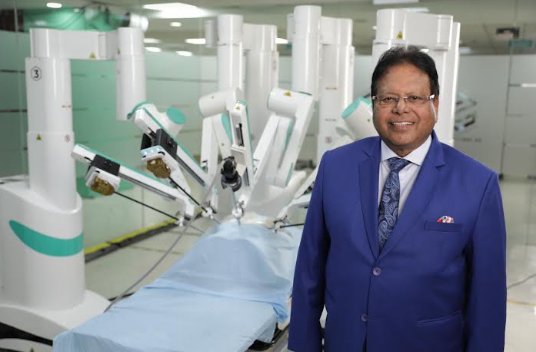"We may witness a reduction in the number of human participants in surgical procedures"
September 15, 2023 | Friday | Views | By Gunjan Sharma
Dr Sudhir Srivastava, Founder and CEO of SSi Innovations, developed Mantra, the first made-in-India Robotic Surgery System, along with several other surgical equipment and devices. He talks to BioSpectrum about how this breakthrough technology is bringing clinical efficacy to surgeries and becoming cost-effective.
What motivated you to bring robotic surgery technology to India, and how did you fund the initiative?
During the early 2000s, there was only one company offering robotic systems for surgery, and their cost was prohibitively high, which limited global access to just 7 percent of the world's population. Having performed over 1000 heart procedures using the robot, I knew its advantages. Robot-assisted surgeries significantly reduced hospital stays and accelerated the recovery process for patients.
So, in 2011, I decided to return to India and introduce this technology to the country. But at that time there were only 5-7 robotic surgical systems in use across India.
During my early days in India, a patient was brought to me by his elder brother. The patient was a young man of marriageable age with a hole in his heart. His brother requested a procedure that wouldn't leave a scar on the front of the chest, as it would affect his marriage prospects. I told them we could do it with robotic surgery, with four minor incisions and no scar on the front, but it would cost about Rs 4 lakh. He left, saying he would try to arrange the money in a week's time, but we never heard from him. I tried to contact him but couldn't. That incident pained me, and I decided to come up with a cost-effective technology. I sold my car and my furniture to fund the initial research.
What features does your Mantra robotic surgery machine offer, and how does it benefit surgeons?
Developed by young engineers in India, the Mantra robotic surgery machine provides a range of advanced features tailored to benefit surgeons. The system boasts an intuitive and ergonomic surgeon's command centre that works with five robotic arms. This console is equipped with dual monitors, one for real-time visualisation of the surgical site within the patient's body and the other for accessing additional imaging data. Our system uses cutting-edge web3-based technology to provide 3D holographic DICOM imaging and artificial intelligence (AI)-based anatomy segmentation. It even allows virtual surgery option to the surgeon, wherein the surgeon first does the surgery virtually using the imaging before he actually performs it on the patient. It helps us to be precise, and shortens the learning curve. The system is also equipped for tele-monitoring and training.
How does robotics enhance the patient's experience in cardiac surgery?
Robotics ensures less pain, less trauma, and shorter hospital stays for patients. I have seen patients resuming their normal activities, such as driving, just two days after heart surgery. The precision and finesse offered by robotic technology greatly enhance a surgeon's capabilities.
Moreover, robotics enables tele-surgery, which enables an expert surgeon located miles away, to provide guidance to the performing surgeon in real-time. This has the potential to revolutionise healthcare delivery in remote areas of the country, ensuring that patients in underserved regions can access high-quality medical care.
What types of cardiac surgeries can be performed using the robotic system, and what unique capabilities does it offer?
Our robotic system can perform 40 different procedures, including coronary bypass, repair of congenital defects, excision of tumours, etc. It has the unique capability of combining two arteries in bypass surgeries in just six seconds and offers advanced features like virtual reality and mixed reality.
What is the cost of your robotic system compared to others, and what pricing models are available for its purchase?
The Mantra robotic system is priced at approximately Rs 5 crore, which is much less expensive than other available robotic systems. Various pricing models are designed to facilitate the acquisition of these machines by government institutions and smaller hospitals, making them more accessible. Insurance schemes cover the cost of endoscopic surgeries, starting at around Rs 50-60,000, and heart surgeries, which begin at Rs 90,000, ensuring affordability and accessibility for patients.
How do you envision the future role of AI and machine learning in robotic surgery?
I foresee a significant role for AI and machine learning in robotic surgery, which has the potential to automate specific surgical tasks, particularly those involving fixed anatomical structures. Over time, we may witness a reduction in the number of human participants in surgical procedures, with robots and AI assuming greater responsibilities in the surgical process.
What is the goal regarding the accessibility and decentralisation of this robotic surgery technology?
Our goal is to decentralise excellence and enhance accessibility by bringing this technology to remote and underserved areas. We are exploring innovative approaches, such as mounting the system on a mobile unit or truck, to ensure that people in remote regions can benefit from the advancements in robotic surgery.
Gunjan Sharma
gunjan.sharma@mmactiv.com










